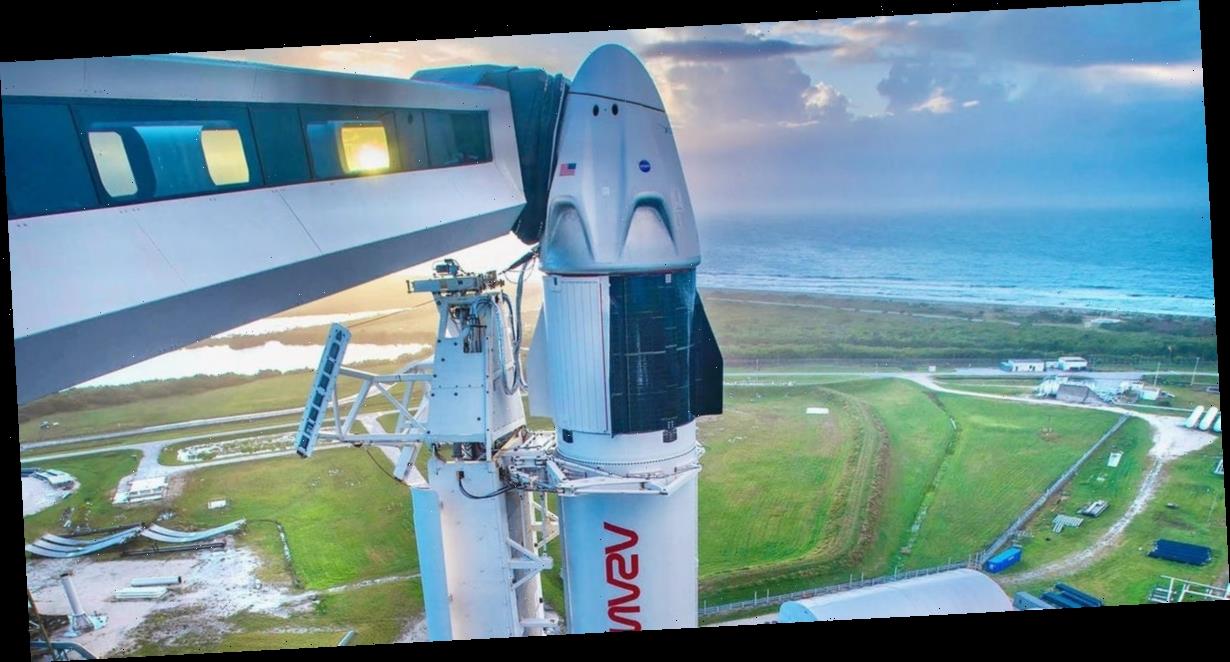- SpaceX and NASA are attempting to launch their Crew-1 mission on Sunday: the longest and most ambitious US human spaceflight to date.
- Poor weather near the launchpad, or any other delays, at the moment of planned launch will cause mission managers to call off an attempt; SpaceX's Falcon 9 rocket can't wait another second.
- Falcon 9's ultracold fuel warms up and vents out as it sits on the launch pad. This causes the machine to have less margin for error in sending people to orbit.
- When a Crew Dragon spaceship is on top with passengers inside, the rocket must lift off 35 minutes after fueling begins. It also has to align with the International Space Station flying overhead.
- Visit Business Insider's homepage for more stories.
SpaceX on Sunday night plans to launch NASA's most ambitious crewed mission yet with the flight of four astronauts to the International Space Station.
Called Crew-1, the mission will carry Mike Hopkins, Victor Glover, and Shannon Walker of NASA, as well as Soichi Noguchi of the Japan Aerospace Exploration Agency, inside a Crew Dragon spaceship. The tight-knit group aims to stay at the ISS for six months; if they succeed, their mission is poised to break the US record for longest human spaceflight.
However, right now there's a 50% chance of weather delay due to poor conditions near the launch site at Kennedy Space Center in Cape Canaveral, Florida.
"Rain in the flight path, thick clouds, and possibly static electricity at ground level might be an issue," SpaceX engineer John Insprucker said during NASA's livestream of launch preparations Sunday afternoon.
And that's not considering the conditions near emergency recovery zones in the ocean for the mission's Crew Dragon spaceship, nor SpaceX's Falcon 9 rocket-booster-catching drone ship. For now, Insprucker said, these splashdown locations are "go."
If anything interferes with plans for the exact moment of launch, which is scheduled for 17 seconds after 7:27 p.m. ET, mission managers will scrub the attempt and try again another day.
Such a sensitive launch window is called "instantaneous," and it exists because of the rocket's design, NASA safety requirements, the trajectory of the ISS over Earth.
Back in May, with SpaceX's first attempt to launch people into space — a mission called Demo-2 — puffy clouds were bound to break flight rules at the moment of launch, triggering a scrub.
"Everything was looking our way except mother nature: the weather," Insprucker said in the livestream of Demo-2's first launch attempt.
With Crew-1, onshore winds now threaten to delay the flight a second time. But NASA chief Jim Bridenstine tweeted on Sunday afternoon those conditions "are within margins" and that SpaceX is "still a go for launch."
Here's why a crewed SpaceX launch can't wait a single second longer after it's supposed to lift off.
The twin problems of ultracold fuel and a laboratory moving at 17,500 mph
Once SpaceX starts fueling a Falcon 9 rocket, it begins a process in which imprecise timing could mean life or death.
"Once you get into propellant loading at T-minus-35 minutes, you have to go as soon as you get to zero," Insprucker said in May ahead of Demo-2's first scrubbed flight attempt. "We don't have the ability to stop the countdown, wait 5 minutes."
That's because liquid oxygen is pumped into the Falcon 9 at a very low temperature: 340 degrees Fahrenheit below zero. That keeps it liquid and densifies the fuel, a type of kerosene called RP-1, which allows SpaceX to cram more of it into the rocket and squeeze more performance out if the machine.
In fact, it's part of what gives the Falcon 9 its unprecedented thrust — the force behind its launch that allows it to push more than 50,000 pounds of cargo into orbit. The extra reserves also provide more wiggle room to reach orbit, and for SpaceX to land and recycle the rocket's booster — the biggest and most expensive part of the Falcon 9.
Once inside the rocket, however, the fuel begins to warm up, expand, and boil off. That fuel loss starts the launch clock ticking.
"That changes how much performance you get carrying into orbit, and we don't want to cut into those margins," Insprucker said.
Essentially, any additional time the rocket sits fully fueled on the launchpad increases the risk of dangerous failure — a risk that is not worth taking when there are humans on board.
So the Falcon 9 must launch at the exact scheduled second. If it misses that brief window with a satellite, Insprucker explained, the rocket can be detanked of its fuel and later reloaded with fresh fuel and cold liquid oxygen — a process that takes roughly an hour and a half.
But that is not an option for missions to the ISS, which flies over Earth's surface on a winding path (due to its inclination) and at great speed.
"In the case of the International Space Station, an hour and a half from now, it's nowhere where we need to be to get to orbit," Insprucker said. "In the end we can all look at Isaac Newton and Johannes Kepler for orbital dynamics telling us 'when do we launch?' that stuck us right in the middle of a period of bad weather."
If NASA and SpaceX call off Sunday's launch attempt, they can try again on Wednesday night. According to a forecast issued Sunday by the US Air Force's 45th Weather Squadron, a midweek attempt would have considerably better weather with only a 20% chance of delay.
This story has been updated with new information. It was originally published at 1:51 p.m. ET on May 30, 2020.
Do you have a story or inside information to share about the spaceflight industry? Send Dave Mosher an email at [email protected] or a Twitter direct message at @davemosher. More secure communication options are listed here.
Source: Read Full Article
